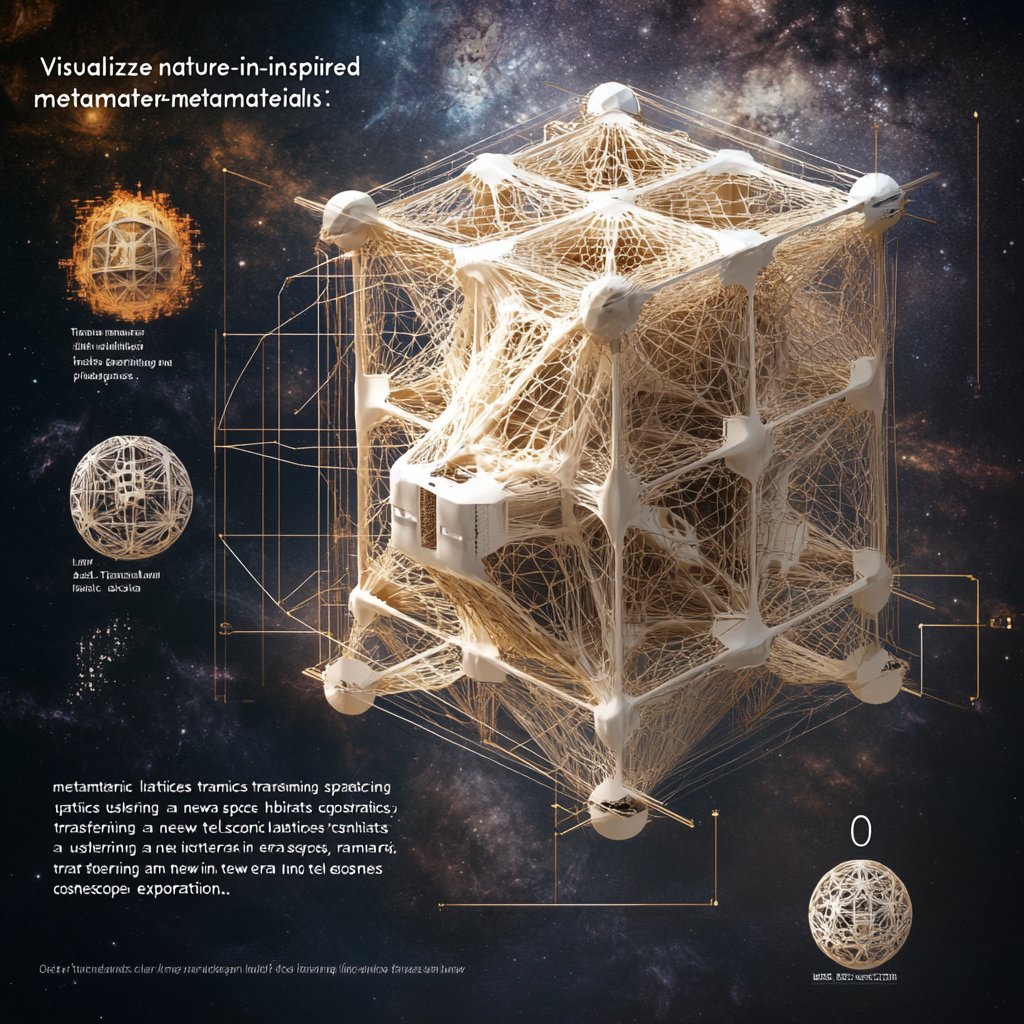
Nature-Inspired Metamaterials: Transformative Space Structures
Ah, space exploration—the final frontier. A realm where dreams take flight and humanity's curiosity drives us into the cosmic blue. But just like trying to make a decent cup of coffee at a chain café, humanity’s approach to space has often been marred by a lack of creativity and quality—until now. Enter “metamaterials,” the surface of which can adapt, transform, and flex like a Swiss Army knife of space tech, inspired entirely by nature. If that doesn’t spark your imagination, I don’t know what will.
Let’s dive into how these metamaterials, with their shapeshifting abilities, could change the way we think about space habitats and telescopes, transforming them into versatile space companions, much like how our smartphones evolved from simple communication devices to miniaturized powerhouses for everything from photography to online shopping. Yes, the future is indeed bright.
Nature: Our Ever-Resourceful Mentor
You’ve probably noticed that nature has a knack for creating complex structures from seemingly elementary components. Coral reefs, for example, are basically underwater cities, formed by little coral polyps banding together like a community of tiny architects. And skeletal structures—like our bones—are surprisingly strong yet lightweight, a perfect combination for any aspiring astronaut’s crib. These phenomena aren’t accidents; they embody principles of efficiency that scientists have finally started to pay attention to.
So why reinvent the wheel when nature has been rolling it out for millions of years? Its elegant designs offer blueprints for innovative materials capable of extraordinary feats. That’s where metamaterials come into the picture—constructed units tailored to mimic the very versatility seen in living organisms. These engineered materials can alter their shape based on external stimuli such as electric fields or physical compression. Think of them as the ultimate transformer, ready to adapt at a moment's notice.
Welcome to the Age of Metamaterials
Ah, metamaterials. Initially, they might sound like a term plucked straight out of a sci-fi flick. But let’s break it down. These bad boys can manipulate and change their structure in real-time, making them ideal for space. Imagine launching a single, simple component that can transform into various structures in space, instead of hauling around heavy, complex machinery. It’s akin to rolling up a flat-packed IKEA sofa and watching it expand into a comfortable living room piece in mere minutes.
Now let’s cue the hero of our story: totimorphic lattices. The name sounds fancy, but here’s the gist: they consist of triangular configurations that can shift and bend into innumerable formations. Picture that perpetual childhood fascination with origami; the possibilities extend far beyond a paper crane! Because of their clever construction, these lattices can reconfigure into different spatial arrangements without needing a truckload of complicated instruments.
From Theoretical Catwalks to Practical Highways
Speaking of applications—let’s jump into some of the exciting directions this technology is headed. Researchers at the European Space Agency (ESA) are cooking up some truly mind-blowing concepts. Imagine sliding a habitat module into a rocket, launching it into outer space, and having it instantly morph into the perfect living space for astronauts on Mars. Why build several structures when you can have one that adapts as mission dynamics change? It’s brilliant! The totemic lattices would allow habitats to customize themselves for lunar nights or Martian days, ensuring comfort and functionality as mission needs evolve.
Then there’s the world of space telescopes. Imagine a telescope that doesn’t just sit there, stiff and unyielding, but actively adjusts its lens curvature to gather the best possible data on whatever elusive cosmic object catches its eye. Sounds like science fiction, right? Nope, it’s on the horizon! Just think—one adaptable telescope could set its sights on a quasar one moment and then shift to study a distant galaxy the next, whipping the photographic potential of space observation market into shape.
Obstacles Along the Cosmic Yellow Brick Road
Now, before you hop on the spaceship headed for the stars, let's bring it back down to Earth for a moment. The challenges facing the physical realization of these metamaterials aren’t trivial. Engineering something with the ability to effortlessly morph from one shape to another involves a great deal of finesse. It's like writing an epic novel—every plot twist and character needs to intertwine smoothly for the narrative to flow.
Enter AI. Yes, our digital counterparts might just hold the key to demystifying these complex structures through predictive modeling. Just as AI has transformed things like facial recognition, it can be an immense asset in helping to simulate how metamaterials will behave in various scenarios. It’s like having a super-smart assistant who alters the story before you even finish writing it.
Walking the Metamaterial Walk
But don’t get too comfy; the world of metamaterials is far from limited to totemic lattices. There are other innovative works brewing, like a 2D metamaterial surface crafted by scientists at the University of Glasgow. This ultrathin wonder is poised to enhance satellite communication and remote sensing capabilities. Imagine the possibilities! More agile communication across distances of space, better data quality, and improved efficiency—just what we need while spacing out about what’s up there in the cosmos.
Charting the Path Forward
The adventure to create these nature-inspired metamaterials is just the prelude—a tease to what might be. As excited as we are about their potential, we’re still in the early chapters of this remarkable story. However, the vision of flexible habitats and multifunctional telescopes is not just an abstract dream; it’s rapidly becoming our reality.
We stand on the edge of a new era of exploration—where adaptability could enable us to unlock new realms of possibilities. The cosmos is calling, and with these shapeshifting materials, we may soon be ready to answer. The future is under construction, and it’s shaping up to be nothing short of extraordinary!
Want to stay up to date with the latest news on advanced materials and space technology? Subscribe to our Telegram channel: @channel_neirotoken.
As we continue unfolding this cosmic narrative, remember that the best chapters are yet to come; it’s time for humanity to step into the next era of exploration armed with innovation, none other than those marvelous metamaterials inspired by nature itself.

